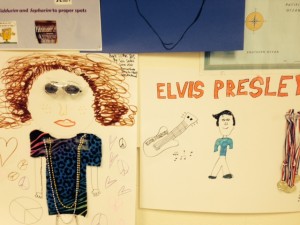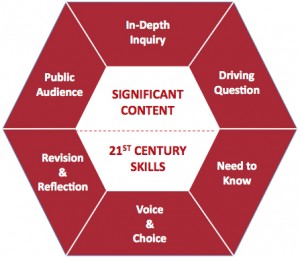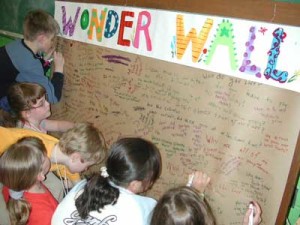The Need to Know
So far, Eliezer Jones and I have introduced the basic components of PBL and discussed how it includes significant content. This post will explore the Need to Know that is a crucial part of setting up a successful PBL unit. To review, let’s consider the component, described by the Buck Institute of Education (BIE):
Students see the need to gain knowledge, understand concepts, and apply skills in order to understand the Driving Question and create project products, beginning with an Entry Event that generates curiosity and interest.
We’ll explore the Driving Question in greater depth in a later post, but for those who need an explanation of it, it’s the question that drives the learning and that connects it to a real-world problem or application. For a quick peek at Driving Questions, check out this blog post from edutopia, one of our favorite sites for PBL.
Is This Going to Be on the Test?
As educators, we all know that unfortunately often the driving question for students is: Is this going to be on the test? We’re greedy, though. We want students to be curious and engaged, and we don’t want them to just be “doing school”; we want them to love learning and be lifelong learners. This is why the Need to Know is such an important component of PBL: it arranges and arrays the learning in such a way that it becomes vital for the student to know it.
Creating the Need
What, then, creates the Need to Know?
Looking at the BIE’s image of PBL components, I find it significant that the Need to Know is flanked by the Driving Question and Voice and Choice. A fascinating Driving Question will certainly spark in students a desire to know, but these questions must be appealing to students, not teachers. Teachers may have a Need to Know how force and velocity work, why World War I began, or what Hamlet’s problem really is, but students may not be particularly interested in those ideas. Instead, educators have to think about where students are and bring the Need to Know to their page. I might consider the following Driving Questions:
How might an understanding of force and velocity help me design athletic gear that will improve athlete performance?
How can an understanding of the way countries go to war help me understand how to fight terror today or improve relationships in my life?
Is Hamlet a teenager with a lot of angst or something more? How does understanding Hamlet help me understand myself and the difficult transitions I’m going through as an adolescent?
According to the BIE, once you’ve decided on a Driving Question (DQ) that will engage students, your next step is an exciting Entry Event that introduces the DQ and the project as a whole. More about that below.
I also think, though, that resonant driving questions suppose that students are interested in ideas that relate to them in some way, an assumption that the PBL component of Voice and Choice also makes. In fact, it’s a logical and healthy assumption that not only honors students’ inner lives but also all of our own. Learning takes on an added dimension when a student and teacher feel personally invested in it. Therefore, another way to get students to address a Need to Know is to give them Voice and Choice in class and find out what about the topic interests them.
Wonder Walls
A lot of teachers are creating Wonder Walls in their classrooms, asking students to write down what they want to know — either in general or about a specific topic in a course syllabus. Teachers can decide what they want to do with that information. For example, using Google’s 80/20 model, teachers can devote class time to allowing students to explore a topic of interest on their own. The passion for learning the Google model elicits can spill over into the rest of the course. Or, teachers can use students’ interests as a springboard for the learning in their class, building students’ interests into the course material.
An Example

It’s up to you as an educator to decide what to do when your students tell you they’re interested in the 80’s (poster on the left) or Elvis in the 60’s (poster on the right)
For example, a Jewish history teacher at Magen David HS, Ms. Frieda Cattan, is covering Classical Judaism this year, and she began the course by asking her students what period of history they’re most interested in. Students then had to use props and other art supplies to bring that time to life on a poster board. Since Ms. Cattan’s Driving Question for the year is How Did We Jews Get Here Today?, she can use the students’ interests in a particular time period to help them wonder how we got from the Classical world to their favored period. Ms. Cattan can also have her students compare their favorite era with the Classical world, and since Ms. Cattan asked students to imagine a role for themselves in their preferred period, she can now also ask them to trace what that role looks like going back in time to the Classical world. In fact, endless opportunities pop up to connect the course syllabus to student interest, now that Ms. Cattan knows what those interests are.
Make the Time
One of the biggest concerns teachers have expressed when given these suggestions is how to make them work in a course where time is never sufficient: a course may have an important standardized test at its culmination or a particularly content-rich syllabus. We believe, though, that learning becomes easier when student passions are engaged, when the classroom is alive with the vitality of those interested in what is going on there. The truth is that the Need to Know has always existed in the classroom, but PBL, with its student-centered focus, places the onus of responsibility on the teacher to discover what might make his/her students not just interested in learning but truly compelled to discover what a course is all about.
Additional Resources
Entry Event into a Unit on the Human Body
An engaging Entry Event, which enables teachers to spark excitement and interest about a learning unit, is a good way to establish a Need to Know. We love this teacher-made video which, as an entry event into a unit on the human body, got kids thinking about why an understanding of the body is vital to their lives. Note how the teachers incorporated their own passions into the entry event video. Passion-based learning always adds a personal dimension to class that everyone — teacher and student — benefits from:
Suzie Boss on Project Launches
Here is PBL guru Suzie Boss on how to do project launches in an exciting manner.













Leave a reply